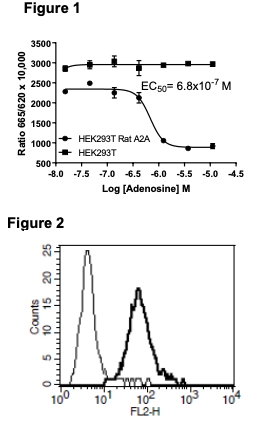Product Information
Catalog Number: Cr1428
Lot Number: Cr1428-070721
Quantity: 1 vial (2 x 106) frozen cells
Freeze Medium: CellBanker2
Host cell: HEK293T
Transfection: Expression vector containing full-length rat ADORA2A cDNA (GenBank accession number NM_053294.5) with FLAG tag sequence at N-terminus
Recommended Storage: Liquid nitrogen upon receiving
Propagation Medium: DMEM, 10% FBS, 1 μg/mL puromycin
Stability: In progress
Data Sheet
Background: Adenosine regulates the function of the innate and adaptive immune systems through targeting virtually every cell type that is involved in orchestrating an immune/inflammatory response. Of the four adenosine receptors (A1, A2A, A2B, A3), A2A receptor is the primary anti-inflammatory effectors of extracellular adenosine. A2A receptor predominant expresses in monocytes/macrophages, dendritic cells, mast cells, neutrophils, endothelial cells, eosinophils, epithelial cells, as well as lymphocytes, NK cells, and NKT cells. Its activation inhibits early and late events occurring during an immune response. A2A receptor also participates in tissue remodeling and reparation. A2A receptor has been shown to impact the course of a wide spectrum of ischemic, autoimmune, infectious, and allergic diseases, and has regulatory roles in immune/inflammatory diseases of various organs, including heart, lung, gut, liver, kidney, joints, and brain. Recently, A2A receptor has become a particularly attractive target to manage psychiatric disorders.
Application: Functional assays

Figure 1. Dose-dependent stimulation of intracellular cAMP level upon treatment with ligand, measured with MultiScreenTM TR-FRET cAMP 1.0 No Wash Assay Kit (Multispan MSCM01) Figure 2. Receptor expression on cell surface measured by flow cytometry (FACS) using an anti-FLAG antibody. Thin line: parental cells; thick line: receptor-expressing cells.
References:
Hasko et al. (2008) Adenosine receptors: therapeutic aspects for inflammatory and immune diseases. Nat Rev Drug Discov 7:759-770.
Linden et al. (1999) Characterization of human A (2B) adenosine receptors: radioligand binding, wester blotting, and coupling to G(q) in human embryonic kidney 293 cells and HMC-1 mast cells. Mol Pharmacol 56:705-713.
Dubey et al. (2002) A2B Adenosine Receptors Stimulate Growth of Porcine and Rat Arterial Endothelial Cells. Hypertension 39: 530-535.
